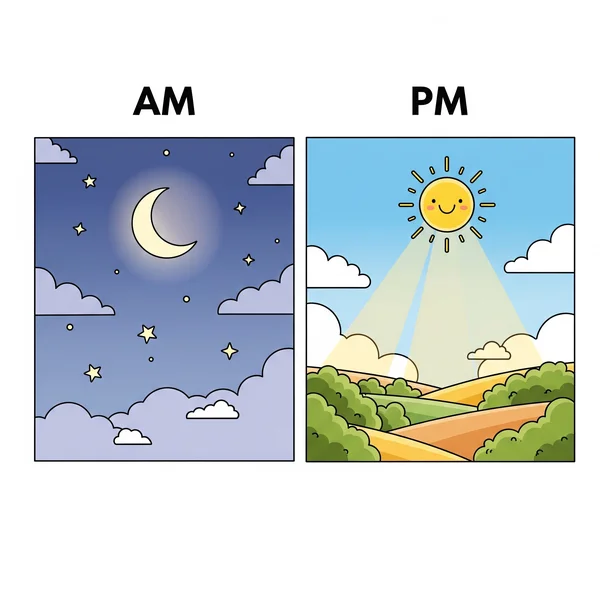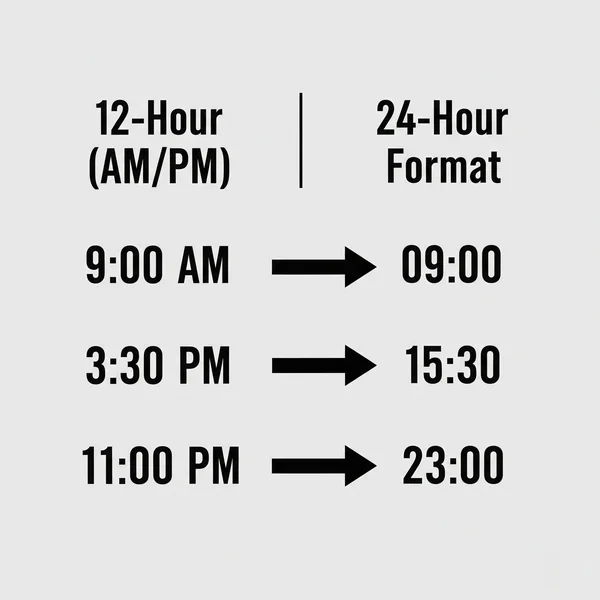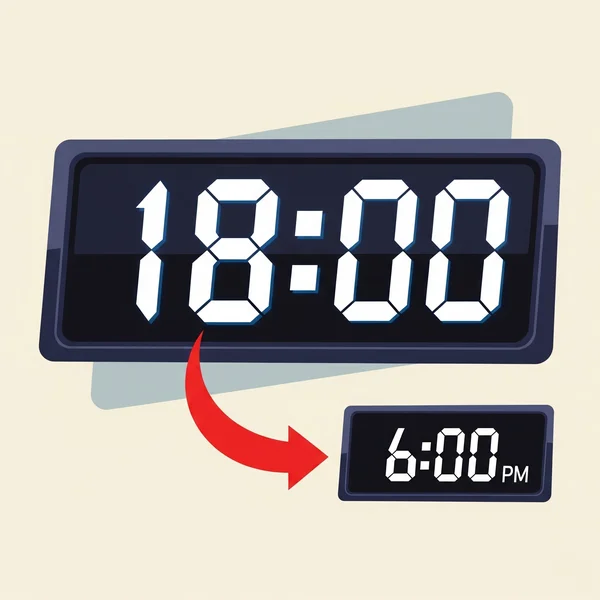Understanding AM/PM and 24-Hour Time Format
So, you've started to get the hang of reading an analog clock, perhaps even by using a helpful online clock tool for practice. That's great! But have you ever wondered what does AM and PM mean, or seen time written like 14:00 and felt a bit confused? You're not alone! Once you can tell time, the next step is understanding the different ways we write and talk about it. This guide will simply explain the am pm meaning, the 24 hour format (often called military time), and how to easily convert time format between them.
What Does AM and PM Mean? Understanding the 12-Hour Clock
The most common way we tell time using an analog clock involves a 12 hour clock cycle, which repeats twice a day. To distinguish between these two cycles, we use AM and PM. What is the difference between 12 hour and 24 hour time in this regard? The 12-hour system needs these labels.
AM: Ante Meridiem (Before Noon Explained)
"AM" stands for Ante Meridiem, which is Latin for "before midday" or "before noon." This period covers the time from midnight up to, but not including, noon. So, 1:00 AM is early in the morning, and 11:00 AM is late morning. Understanding ante meridiem helps clarify the first half of the day.
PM: Post Meridiem (After Noon Explained)
"PM" stands for Post Meridiem, Latin for "after midday" or "after noon." This period covers the time from noon up to, but not including, midnight. So, 1:00 PM is in the afternoon, and 11:00 PM is late at night. Knowing post meridiem defines the second half of the day.

The Special Cases: 12 AM (Midnight) and 12 PM (Noon)
This is where it can get a little tricky!
- 12 AM is midnight. It's the very start of a new day.
- 12 PM is noon. It's the middle of the day. Remembering these two points is key to correctly using the 12 hour clock and understanding time notation.
Introducing the 24-Hour Clock Format (Military Time)
Another way to express time, which avoids any AM/PM confusion, is the 24 hour format, also widely known as military time. Why is the 24-hour clock called military time? While it's used by the military, it's also common in aviation, computing, and many countries around the world for everyday scheduling.
How the 24-Hour System Works (00:00 to 23:59)
The 24 hour format counts the hours from midnight (00:00) all the way through to 23:59 (one minute before the next midnight). Each hour of the day has a unique number, so there's no need for AM or PM. This system provides a clear way for understanding time systems.
Who Uses the 24-Hour Format and Why?
As mentioned, military and emergency services use it for precision. Many European and Asian countries use it as standard. Airlines, train schedules, and even some digital watches use the 24 hour format to prevent mix-ups between, for example, 7:00 in the morning and 7:00 in the evening.
Advantages of Using the 24-Hour Clock
The main advantage is clarity. When you see "17:30," you know instantly it's in the afternoon/evening, without needing a PM. This is very helpful in contexts where accuracy is critical, such as when using a digital clock for precise scheduling.
How to Convert Time: From 12-Hour (AM/PM) to 24-Hour Format
Learning to convert time format is a useful skill. How do you convert AM PM to 24 hours? It's simpler than you might think!
Converting AM Times to 24-Hour (e.g., 9:00 AM is 09:00)
- For AM times from 1:00 AM to 11:59 AM, the hour number generally stays the same. Just write it with two digits if it's a single digit (e.g., 7 AM becomes 07:00).
- Special Case: 12 AM (Midnight): 12:00 AM (midnight) to 12:59 AM becomes 00:00 to 00:59 in the 24 hour format. So, 12:30 AM is 00:30.
Converting PM Times to 24-Hour (e.g., 3:00 PM is 15:00)
- For PM times from 1:00 PM to 11:59 PM, add 12 to the hour number.
- Example: 3:00 PM becomes 3 + 12 = 15:00.
- Example: 8:45 PM becomes 8 + 12 = 20:45.
- Special Case: 12 PM (Noon): 12:00 PM (noon) to 12:59 PM stays as 12:00 to 12:59 in the 24 hour format. It does not become 24:00.

Quick Conversion Chart: AM/PM to 24-Hour
| 12-Hour (AM/PM) | 24-Hour Format |
|---|---|
| 12:00 AM (Midnight) | 00:00 |
| 1:00 AM | 01:00 |
| ... | ... |
| 11:00 AM | 11:00 |
| 12:00 PM (Noon) | 12:00 |
| 1:00 PM | 13:00 |
| ... | ... |
| 11:00 PM | 23:00 |
This time conversion chart can be a handy reference.
Converting from 24-Hour Format Back to 12-Hour (AM/PM)
Going the other way is also straightforward.
From 24-Hour to AM Times (e.g., 07:00 is 7:00 AM)
- If the hour is between 00 and 11 (e.g., 00:xx to 11:xx), it's an AM time.
- Special Case for 00 hours: If the hour is 00 (like 00:30), it's 12:30 AM. For other hours in this range (01:00 to 11:59), the hour number stays the same, just add "AM". (e.g., 09:15 is 9:15 AM).
From 24-Hour to PM Times (e.g., 18:00 is 6:00 PM)
- If the hour is 12 (e.g., 12:xx), it's a PM time (the noon hour). So, 12:45 is 12:45 PM.
- If the hour is 13 or higher (e.g., 13:xx to 23:xx), subtract 12 from the hour, and it's a PM time.
- Example: 18:00 becomes 18 - 12 = 6:00 PM.
- Example: 22:10 becomes 22 - 12 = 10:10 PM.

Remembering the 12 PM (Noon) and 12 AM (Midnight) Conversions
These are often the trickiest:
- 00:00 (24-hour) = 12:00 AM (midnight)
- 12:00 (24-hour) = 12:00 PM (noon) This helps with accurate time conversion.
Why Knowing Both Time Formats is Useful (Even with an Analog Clock)
Even if you primarily use an analog clock and are comfortable with its 12 hour clock display, understanding both AM/PM and the 24 hour format is beneficial. If you need more practice with the basics of telling time on an analog clock, you can always visit our interactive clock page.
Real-World Scenarios: Travel and Schedules
Many travel itineraries (flights, trains) and international event schedules use the 24 hour format to avoid confusion across different time zones and regions.
Avoiding Confusion in Communication
When scheduling meetings or calls, especially internationally, using the 24 hour format or clearly stating AM/PM prevents misunderstandings. It's all part of clear understanding time systems.
Broadening Your Understanding of Time
Learning both systems simply makes you more "time literate" and adaptable in various situations. It complements your knowledge of reading a traditional analog clock face.
Mastering Time Formats: AM/PM and 24-Hour Made Easy
Understanding the am pm meaning and how the 24 hour format (or military time) works doesn't have to be complicated. With the rules and examples we've covered, you can confidently convert time format between the 12 hour clock and the 24-hour system. Like any new skill, a little practice makes perfect!
Do you have any tricks for remembering these conversions, or situations where knowing both has been super helpful? Share your thoughts in the comments below!
Your Time Format Questions Answered (AM/PM & 24-Hour)
Q1: Is 12 PM noon or midnight? A1: 12 PM is noon (midday). 12 AM is midnight (the start of the day). This is a very common point of confusion with the 12 hour clock.
Q2: How do you write 12:30 AM in 24-hour format? A2: 12:30 AM is 00:30 in the 24 hour format. Remember, the 12 AM hour becomes '00' in military time.
Q3: What time is 18:30 in AM/PM? A3: To convert time format from 18:30, subtract 12 from the hour: 18 - 12 = 6. So, 18:30 is 6:30 PM. For more examples, you can practice conversions using various time telling tools.
Q4: Why is the 24-hour clock called military time? A4: It's called military time because armed forces and other services that require unambiguous time-keeping (like emergency services, aviation) adopted it widely to prevent errors that could occur with AM/PM, especially across different time zones or in critical situations.
Q5: How do you convert AM PM to 24 hours? A5: For AM times (1 AM to 11:59 AM), the hour usually stays the same (12 AM is 00 hours). For PM times (1 PM to 11:59 PM), add 12 to the hour (12 PM stays 12 hours). This time conversion is key to understanding the 24 hour format.